Specially for ZenMod so he knows how to built a simple and good sounding Class A amplifier. 😉
https://www.diyaudio.com/forums/attachment.php?attachmentid=992652&stc=1&d=1635099089
https://www.diyaudio.com/forums/attachment.php?attachmentid=992653&stc=1&d=1635099089
https://www.diyaudio.com/forums/attachment.php?attachmentid=992654&stc=1&d=1635099089
https://www.diyaudio.com/forums/att....php?attachmentid=992656&stc=1&d=163509908989
https://www.diyaudio.com/forums/attachment.php?attachmentid=992652&stc=1&d=1635099089
https://www.diyaudio.com/forums/attachment.php?attachmentid=992653&stc=1&d=1635099089
https://www.diyaudio.com/forums/attachment.php?attachmentid=992654&stc=1&d=1635099089
https://www.diyaudio.com/forums/att....php?attachmentid=992656&stc=1&d=163509908989
Attachments
-
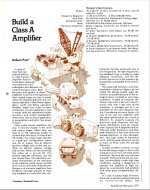 1. Nelson Pass - Build a Class A amplifier - Febr. 1977.JPG308 KB · Views: 851
1. Nelson Pass - Build a Class A amplifier - Febr. 1977.JPG308 KB · Views: 851 -
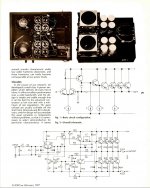 2. Nelson Pass - Build a Class A amplifier - Febr. 1977.JPG183.3 KB · Views: 905
2. Nelson Pass - Build a Class A amplifier - Febr. 1977.JPG183.3 KB · Views: 905 -
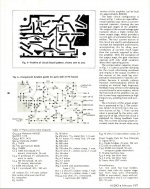 3. Nelson Pass - Build a Class A amplifier - Febr. 1977.JPG254.4 KB · Views: 795
3. Nelson Pass - Build a Class A amplifier - Febr. 1977.JPG254.4 KB · Views: 795 -
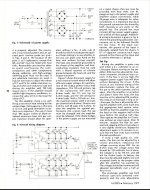 4. Nelson Pass - Build a Class A amplifier - Febr. 1977.JPG315.3 KB · Views: 752
4. Nelson Pass - Build a Class A amplifier - Febr. 1977.JPG315.3 KB · Views: 752 -
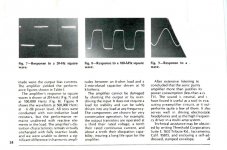 5. Nelson Pass - Build a Class A amplifier - Febr. 1977.JPG128.6 KB · Views: 737
5. Nelson Pass - Build a Class A amplifier - Febr. 1977.JPG128.6 KB · Views: 737
ha!
but you know that I'm not easily impressed .......
lemme see ..... 1977....... I've just changed from second hand 3-speed Czech Favorit to second hand 10-speed French Pitoud ........... and I was in Heaven ...... still at least 4 yrs of first fingerburninsolderfumin'
but you know that I'm not easily impressed .......
lemme see ..... 1977....... I've just changed from second hand 3-speed Czech Favorit to second hand 10-speed French Pitoud ........... and I was in Heaven ...... still at least 4 yrs of first fingerburninsolderfumin'

Attachments
Ha, indeed. At that time ('77) I was soldering Radio Shack kits for various things, including a radio control receiver and servo set for a small RC model airplane.
I assembled & soldered my first stereo amplifier, a Hafler DH-220 in 1982.
I assembled & soldered my first stereo amplifier, a Hafler DH-220 in 1982.
Great!
And as observed correctly already in the Pass DIYAudio Gallery... By you I mean, not by me sorry..
This is a great testament to Nelson Pass, he has always designed amplifiers both commercially and for DIY to last many years. Here is his first DIY project from 44 years ago still running.
Perhaps someone should bring it into the 2020's with new transistors and a PCB layout - I bet many would build it.
Perhaps someone should bring it into the 2020's with new transistors and a PCB layout - I bet many would build it.
I never noticed before but : D3 Any Germanium Diode ... Looks like it's just there for protection.
There are still plenty of Germanium diodes around, not so the specified transistors Nelson used in this amp all those years ago.
D3, I believe it is not critical
though, just starting with first morning coffee, so take it with even more reserve than usual
regarding transistors - just take current Uni types
not enough brain nor time now to calc dissipation of small ones, so can't tell does any of them need to be bigger than TO92
tonight
though, just starting with first morning coffee, so take it with even more reserve than usual

regarding transistors - just take current Uni types
not enough brain nor time now to calc dissipation of small ones, so can't tell does any of them need to be bigger than TO92
tonight
Last edited:
Hi ZM, would be interested in what you would suggest for transistor subs. I would like to build this - as a tribute to Nelson being his first DIY amp project I believe.
Do any members around here have any idea if pcb's were done or if someone might have gerbers to share?
Do any members around here have any idea if pcb's were done or if someone might have gerbers to share?
if I remember to take a look tonight, last night I forgot
though, I believe there are at least few threads addressing something as transistors for A Class amp?
though, I believe there are at least few threads addressing something as transistors for A Class amp?
Q1,2,3,8 - any modern N type in TO92 case - small dissipation here
Q4 P type, Q6 N type, dissipation in range of 330mW, any modern in TO220 case
Q5, Q7 , same as Q6 (TO220 case), dissipation slightly under 700mW, small heatsinks needed
outputs as in article linked in previous post
small ones (TO92) - say ZTX450/550
TO220 - dunno, I'm not overly familiar what's popcorn variety in States and Oz, I would choose oldgoody BD139/140, on this side of big splash
edit: here's what Pa said about (post #27) Threshold 400a Parts Substitution & Mods.
Q4 P type, Q6 N type, dissipation in range of 330mW, any modern in TO220 case
Q5, Q7 , same as Q6 (TO220 case), dissipation slightly under 700mW, small heatsinks needed
outputs as in article linked in previous post
small ones (TO92) - say ZTX450/550
TO220 - dunno, I'm not overly familiar what's popcorn variety in States and Oz, I would choose oldgoody BD139/140, on this side of big splash
edit: here's what Pa said about (post #27) Threshold 400a Parts Substitution & Mods.
Last edited:
Yes ZM, you are Mr Pass's able assistant - many times over.
A bit of research shows the following as transistor subs for this amp from Mr Pass going back to his Threshold days in 1977.
MPSL01 - NPN small signal can be substituted by an MPSA43 or the Zetex ZTX457.
1A16 PNP can be substituted by the NP recommended 2N5415 in the same metal can TO39 package or by a TO220 MJE15031.
1A15 can be substituted by the metal can 2N3440 or by the TO220 MJE15030.
2N5877 in the TO3 package - well I will use the On Semi MJ15003 as I have heaps of them (all original). Then you have all the TO3P and TO264 package types to pick from as well as some more expensive TO3 metal can types.
A bit of research shows the following as transistor subs for this amp from Mr Pass going back to his Threshold days in 1977.
MPSL01 - NPN small signal can be substituted by an MPSA43 or the Zetex ZTX457.
1A16 PNP can be substituted by the NP recommended 2N5415 in the same metal can TO39 package or by a TO220 MJE15031.
1A15 can be substituted by the metal can 2N3440 or by the TO220 MJE15030.
2N5877 in the TO3 package - well I will use the On Semi MJ15003 as I have heaps of them (all original). Then you have all the TO3P and TO264 package types to pick from as well as some more expensive TO3 metal can types.
Nelson mentions that fact in the original article - he gives the bias info for different speaker impedance's.
In Nelson's 1977 article on this Class A amp he states the following.
For an 8 ohm load adjust bias for 125mV across R22 (568mA) for 20 watts output - gives an individual transistor dissipation of around 11.5 watts in the OS.
For a 6 ohm load adjust bias for 170mV across R22 (772mA) for 24 watts output - gives an individual transistor dissipation of around 15.5 watts in the OS.
For a 4 ohm load adjust bias for 220mV across R22 (1000mA) for 28 watts output - gives an individual transistor dissipation of around 20 watts in the OS.
This is based on R22 being 0.22 ohms as per his design and the +/- DC rails being 20VDC from a nominal 14VAC transformer secondary allowing for a usually slightly high mains supply.
For an 8 ohm load adjust bias for 125mV across R22 (568mA) for 20 watts output - gives an individual transistor dissipation of around 11.5 watts in the OS.
For a 6 ohm load adjust bias for 170mV across R22 (772mA) for 24 watts output - gives an individual transistor dissipation of around 15.5 watts in the OS.
For a 4 ohm load adjust bias for 220mV across R22 (1000mA) for 28 watts output - gives an individual transistor dissipation of around 20 watts in the OS.
This is based on R22 being 0.22 ohms as per his design and the +/- DC rails being 20VDC from a nominal 14VAC transformer secondary allowing for a usually slightly high mains supply.
- Home
- Amplifiers
- Pass Labs
- Building a Class amplifierby Nelson Pass - Audio 1977
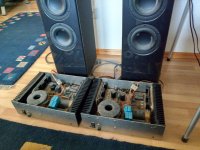

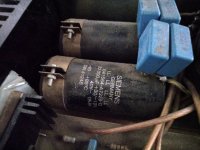
 )
)